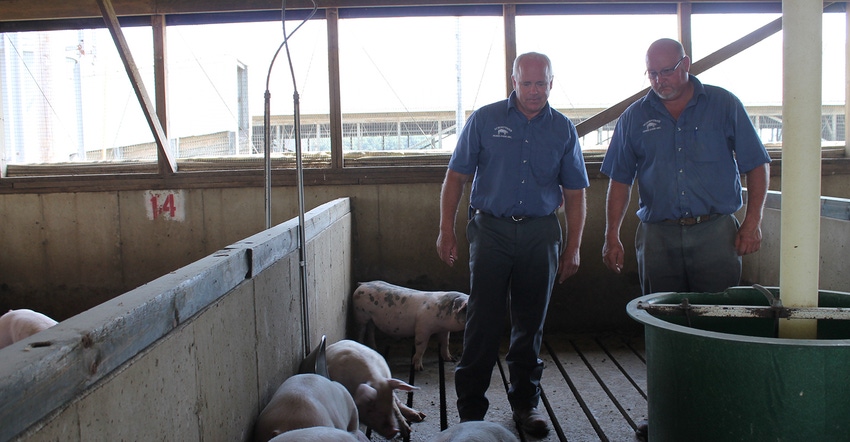Management attitude can make or break the team
Solutions to become a respected leader.
July 30, 2019

By Samantha Marais, Swine Safety Designs
The first hog farm I worked at following college graduation was an integral part of learning how to be empathetic toward my teammates. Upon showering in on the first day, the supervisor said to me, “I hate training new people, so you better catch on quick or you won’t work for me.”
The “training” consisted of shadowing a co-worker, very little explanation of how or why, and after a couple of weeks new hires either sink or swim. The supervisor then evaluated job performance, taking pleasure in telling you how he could’ve done it better. Whoa!!
All of my teammates, including myself, dreaded interactions with him. Even back then it blew my mind, with that attitude, how any of the employees stuck it out. In reality, his turnover rate was astronomical. He constantly complained that he never had any real time off because his phone never stopped ringing. His employees were incompetent and always need questions answered to complete their tasks properly. Well hello?!? How can you expect anyone to succeed or feel confident in their positions if you don’t make their on-boarding and training a priority?
Several years later, I worked for a manager who had the mantra “Everyone is replaceable.” He made it known to all employees. He used the phrase often during our leadership training sessions. Kind of ironic, isn’t it? It wasn’t directed at me, but I can tell you that it’s demoralizing. Those three words carry tones of unappreciation, unneeded and unwanted team members. Now I understand the saying meant we could always find someone else. However, if you really think about it, ultimately, yes, a warm body may be hired. Chances are a new hire will never fully replace a veteran employee with years of experience at your company. Turnover will always cost you more than keeping an employed team member happy. Staff longevity is always better to maintain than to try to replace with new candidates.
Ask any manager and they’ll likely tell you that people are often the hardest part of their career. The reason this is at the top of the list of challenges is because we forget that we can manage objects, pig flow, rations, average daily gains and herds, but you simply can’t manage people.
In order to excel in a management position, one must develop skills to become a leader. This doesn’t automatically happen with a management title. You have to make the decision to be a leader, then actively pursue leadership skill development. For your new employees, it all starts with the interviewing process. Are you hiring people just to have them present at the farm or are you upfront that you have a training program for new hires that prepares them for the position? According to a study by SilkRoad, 53% of human resource professionals say employee engagement rises when onboarding is improved within their training program.
The next vital step is how you approach employee training. Are you an active or absent participant in the process? Are you leading by example? Do you set your team up for success or promote a sink or swim attitude? Are the other leaders on your team all on the same page or does everyone have their own way of doing things? During orientation, do you have any formal training to prepare them for work on the farm or do you just throw them into the showers with little to no warning? Finally, are you approachable or inaccessible to your team?
Answering these questions will help you discover if you need to make tweaks in your management style to be the leader who gets each employee off on a good start.
The next step is to build interpersonal connections with each of your immediate team. This part can be tricky or even impossible if your team members feel intimidated by you. Much like handling your pigs, only use positive, low-stress interactions during on-boarding. A great way to build a rapport with your team is to take the time to find out details about them. What hobbies do they have? Sports? Movie buff? Cooking? I once had a leader who wasn’t a Monday person. I personally enjoy quotes, jokes and memes. “Monday Motivation” became our thing. We would find a motivational quote each Monday and send it before the work day started. It took less than 60 seconds to show him “hey dude, I hear you so here’s a positive way to start your day.” Eventually it grew to a ‘motivational wall’ in the office where our whole team could share funny, meaningful quotes or pictures with the rest of our teammates. It could be as simple as bringing breakfast once in a while for the team on load-out days — then making a point to sit and chat with them at break. Get to know them, find out where they excel in their positions.
Once they’ve completed on-boarding, your continued participation is required. This keeps communication lines open. This is where regularly scheduled team meetings come into play. This is your chance to present up-to-date, ongoing training to the entire team. Bring your safety culture to life. Reinforce to your team that you value them and are willing to invest in their future with the company. This time could also be your opportunity to acknowledge any team or personal achievements that have occurred. Keep in mind that employees whose managers consistently acknowledge them for good work are five times more likely to stay at the company.
For many, positive reinforcement takes practice. This is because many of us have grown accustom to looking for areas in need of improvement. At the very least have equal coachable topics to positive reinforcement topics. Personally, I like to use the 5-to-3 ratio, 5 positive, 3 coaching. Repeat and remember the phrase “praise in public, coach in private.” Nothing breaks trust like humiliation in front of one’s peers. As a leader you always avoid “ripping into” any team member. Coachable moments should be handled with an impromptu training session, using a hands-on approach. Coaching should never include belittling, name calling or challenging one’s intelligence. I promise you that keeping your temper is far more constructive to your leadership reputation than making your team walk on egg shells.
Training at all stages of employment is critical. Now more than ever, companies should really be thinking about how to implement the expectation for all team members to participate in regular training sessions. Team training sessions accomplish two goals. First, it allows you the opportunity to present up-to-date industry topics that impact your herd. Second, it cultivates and encourages team building. At Swine Safety Designs we’ve found that each training experience should fit these three criteria.
Training must be meaningful to their jobs. Learners should easily be able to see how it can be implemented at their farms.
Training must be engaging to the audience. Keep it interesting and thought provoking. The best length per session is 12 to 15 minutes of material covered, with five to 10 minutes of follow-up discussion. There will be times when all the vital information can’t be squeezed into that time frame. I suggest breaking the topic up into a few subtopics that are five- to six-minute intervals. Add some type of activity in between each subtopic to keep everyone engaged.
When training is complete, monitor its implementation at the farm. Make it worth everyone’s time and effort to participate in training. If your team members aren’t taking what they’ve learned back to the farm, they’ll likely develop a passive attitude about being forced to attend training.
Gone are the days that hogs are raised on small family farms. Commercial hog farming has opened the opportunity for five generations to work alongside each other. Baby Boomers, Generation X, Xennials, Millennials and Gen Z’s. Each generation has very different motivation, skills and career goals. When and how you implement a training program should cater to each one of the generations you have working together. Technology has made it possible to pique the interest of Millennials and Gen Z’s while also maintaining a simple visual aide that directly relates to a hands-on approach for the Baby Boomers, Generation X and Xennials.
In conclusion, statistics have shown that training improves employee performance and productivity. This will have a ripple effect to the pigs in your herd. Both breeding and market animals perform better when they are properly cared for. It’s a no-brainer to want to improve pig performance. Are you ready to invest in leadership and employee training, knowing that it could positively impact herd productivity?
Source: Samantha Marais, Swine Safety Designs, who is solely responsible for the information provided, and wholly owns the information. Informa Business Media and all its subsidiaries are not responsible for any of the content contained in this information asset.
You May Also Like


